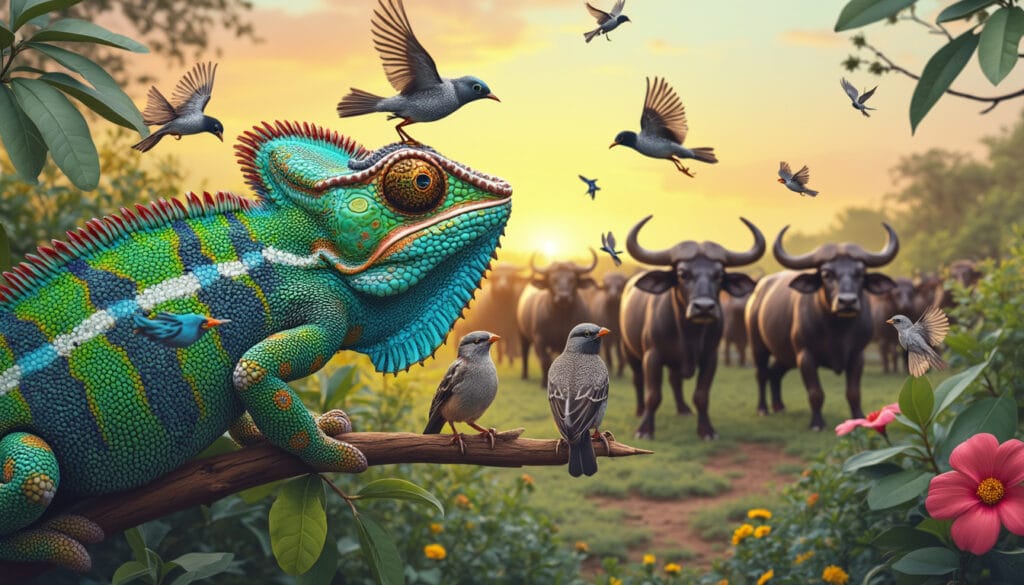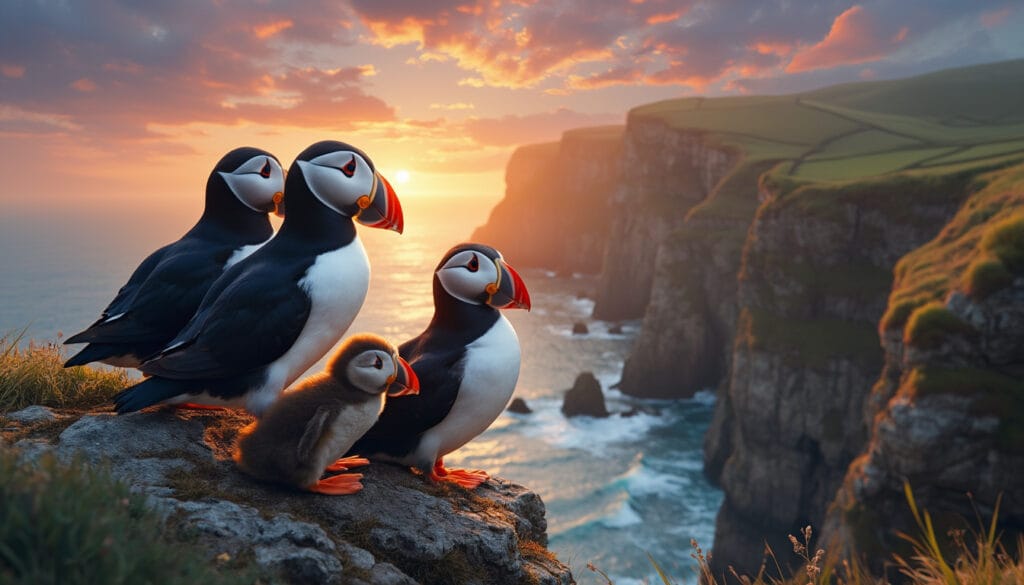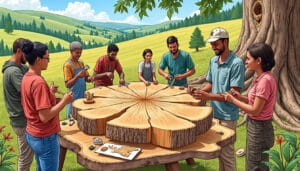Dive into the heart of the wild where every day reveals unsuspected wonders. Discover fascinating creatures and astonishing behaviors that shape our biodiversity. Experience an unforgettable adventure to the rhythm of the thriving wildlife.
The world’s wildlife is filled with hidden treasures and intriguing phenomena. This week, we explore the astonishing diversity of rare chameleons, the social behaviors of starlings, and the reproductive cycles of buffalo. Each species plays a crucial role in the balance of ecosystems, illustrating the richness and complexity of nature. Through concrete examples and recent studies, this article highlights the importance of animal conservation and protection to preserve our natural heritage.
The chameleon: master of adaptation and jewel of biodiversity
The chameleon is one of the most fascinating and diverse reptiles on the planet. With nearly 200 species distributed globally, these lizards are known for their extraordinary ability to change color, their extendable tongue, and their eyes capable of moving independently. This adaptability makes the chameleon a true symbol of biodiversity and a valuable indicator of the health of the ecosystems in which it evolves.

A recent discovery has shed light on the Belalanda chameleon, a critically endangered species endemic to Madagascar. Researchers located a small group in an previously unexplored area, revealing a new facet of the diversity of this threatened species. This finding underscores the importance of continuous research and the protection of natural habitats to prevent the extinction of these jewels of nature.
The camouflage mechanisms in chameleons
Camouflaging in chameleons is much more than just a simple change of color. It encompasses a complex mechanism involving pigment cells called chromatophores, iridophores, and melanophores. These cells work in harmony to allow the chameleon to adapt to its environment, whether to protect itself from predators or to communicate with its peers. This ability to adapt is a remarkable example of evolution and natural selection.
In addition to their camouflage, chameleons possess an extendable tongue that can reach twice the length of their body in a fraction of a second. This unique characteristic allows them to capture prey with astonishing precision, making them effective predators despite their often slow and contemplative appearance.
The conservation of chameleons is essential to maintaining the balance of the ecosystems where they play a key role in regulating insect populations. Protection efforts, such as those conducted by Association Lia, are crucial to safeguard these species against threats such as habitat destruction and the illegal trade in exotic animals.

| Species | Habitat | Conservation Status |
|---|---|---|
| Madagascar Chameleon | Tropical forests | Critically endangered |
| Panther Chameleon | Dry forests of Africa | Vulnerable |
| Chapman’s Pygmy Chameleon | Forests of Malawi | Endangered |
The diversity of chameleons and their unique adaptations make them fascinating subjects for researchers and nature enthusiasts. To learn more about these amazing reptilians, visit Sciences et Avenir.
Starlings: sociable birds with complex behavior
Starlings are famous for their murmuration formations, where thousands of birds move in perfect synchronization. These aerial spectacles are not only spectacular to observe but also play a crucial role in protecting birds from predators. The coordination and communication among starlings are fascinating examples of animal social behavior.

Starlings are ubiquitous in many regions of the world, adapting to various environments, from urban areas to agricultural fields. Their ability to form massive groups allows them to share information about food sources and to protect each other. This form of social collaboration is essential for their survival and success in various habitats.
The dynamics of murmurations
The murmurations of starlings are a phenomenon intensively studied by scientists. These coordinated movements result from effective communication between individuals and their collective perception of the environment. Starlings respond rapidly to changes in direction and speed, creating complex and beautiful patterns in the sky. These collective behaviors are an excellent example of the intelligence and adaptability of birds.
Beyond their beauty, starlings play a significant ecological role by regulating insect populations and contributing to seed dispersal. Their presence in various ecosystems helps maintain the natural balance and promote biodiversity. However, starlings face threats such as habitat loss and climate change, making their conservation essential to preserve these unique behaviors.
Protection initiatives, such as those described by Geo Environment, are in place to ensure the survival of starlings and maintain their ecological role. These efforts include the conservation of natural habitats and research on environmental impacts affecting these social birds.
| Aspect | Description | Ecological Importance |
|---|---|---|
| Murmurations | Synchronized movements of large groups | Protection against predators |
| Insect Regulation | Consumption of large amounts of insects | Maintaining population balance |
| Seed Dispersal | Transport and deposition of seeds via droppings | Promotion of plant biodiversity |
Starlings, with their complex social behaviors and essential ecological role, are a pillar of global wildlife. To deepen your knowledge about these fascinating birds, visit J’ai Tout Compris.
Buffalo in heat: reproductive cycles and ecological impact
Buffalo are iconic mammals of African and Asian ecosystems. Their reproductive cycle, marked by periods of heat, influences not only their own population but also the entire ecosystem in which they live. Understanding these cycles is crucial for the management and conservation of these powerful animals that are necessary for biodiversity.
Buffalo play a central role in habitat structuring. By grazing on vegetation, they help regulate plants and create open grasslands, promoting diversity in both plant and animal species. Their presence also helps create temporary water points by digging in the soil, which benefits other animals during dry periods.
The reproductive cycle of buffalo
Buffalo have a seasonal reproductive cycle, with periods of heat triggering reproduction. These periods are influenced by environmental conditions and the availability of food resources. During the breeding season, males compete for the right to mate with females, demonstrating dominance and competitiveness behaviors.
Understanding the reproductive cycles of buffalo is essential for conservation efforts. By observing these cycles, ecologists can better plan interventions to protect populations during critical periods. Moreover, buffalo are often considered indicator species, reflecting the overall health of the ecosystem.
Conserving buffalo is closely linked to protecting natural habitats and managing water resources. Initiatives aimed at preserving grazing areas and ensuring adequate water supply are vital for maintaining buffalo populations and, by extension, the entire ecosystem. Reliable statistics show that buffalo contribute to species diversity, enhancing the resilience of ecosystems to climate change.
| Phase | Main Activities | Ecological Impact |
|---|---|---|
| Heat Season | Reproduction, territorial disputes | Population increase |
| Dry Season | Migration to water points | Creation of temporary water points |
| Rainy Season | Intensive feeding, herd growth | Regeneration of vegetation |
Buffalo, with their reproductive cycles and ecological role, are indispensable actors in global wildlife. Their preservation is essential to maintaining the balance of natural habitats and ensuring the sustainability of various animal and plant species. To learn more about the ecological impact of buffalo, consult Le Figaro Animaux.
Interactions between species: chameleons, starlings, and buffalo
Interactions between different species are essential for the health of ecosystems. Chameleons, starlings, and buffalo, although very different, illustrate how species can coexist and mutually influence each other. These complex relationships bolster the resilience of natural habitats against environmental disturbances.
Chameleons, as insect predators, help regulate the populations of these insects, which has an indirect effect on buffalo. A healthy buffalo population requires balance in the food chain, where insects play a crucial role in decomposing organic matter and recycling nutrients.
The role of starlings in the ecosystem
Starlings, through their murmuration behavior, help in seed dispersal and controlling insect populations. This dual function is beneficial for buffalo, as it maintains the quality of available food and contributes to the plant diversity of pastures. Furthermore, starlings can benefit from buffalo by perching on their backs, using these large mammals as safe resting points away from predators.
Buffalo, while galloping through grasslands, create paths and clearings that facilitate the movement of starlings and other bird species. This dynamic interaction shows how the actions of one species can have positive consequences for others, thus reinforcing ecosystem cohesion.
The conservation of these interactions is crucial for maintaining biodiversity. Targeted protection programs, such as those described by Nature et Faune, highlight the importance of preserving not only the species individually but also the complex relationships that bind them. These efforts aim to create environments where each species can thrive in harmony with others.
| Species | Interaction | Global Impact |
|---|---|---|
| Chameleon | Insect regulation | Maintaining food balance |
| Starlings | Seed dispersal, insect control | Increase in plant biodiversity |
| Buffalo | Path creation, grazing | Improvement of habitats for other species |
The interactions between chameleons, starlings, and buffalo demonstrate the complexity and interdependence of species within ecosystems. To explore further the relationships between different species and their impact on biodiversity, visit The 5 things to know about chameleons.
Conservation initiatives: protect wildlife and preserve biodiversity
Faced with growing threats such as deforestation, climate change, and illegal animal trade, conservation initiatives are becoming essential to protect wildlife and preserve biodiversity. Concerted efforts at both local and global levels aim to safeguard natural habitats and ensure the survival of threatened species.
Chameleons, starlings, and buffalo benefit from various protection initiatives. Strict nature reserves, captive breeding programs, and public awareness campaigns are some of the strategies employed to ensure the survival of these iconic species. Collaboration between scientists, governments, and NGOs is essential for the success of these conservation efforts.
Innovative technologies for conservation
Modern technologies play a crucial role in wildlife conservation. The use of drones to monitor chameleon and buffalo populations, as well as GPS tracking applications to study starling movements, allows researchers to collect accurate and real-time data. These tools facilitate informed decision-making and the development of effective protection strategies.
Furthermore, habitat restoration initiatives, such as reforestation and the creation of ecological corridors, help reconnect fragmented habitats and allow the natural movement of species. These actions promote the resilience of ecosystems and increase the chances of species survival during periods of environmental stress.
Organizations like Association Lia play a key role in implementing conservation projects. Their expertise and commitment enable targeted protection programs and involve local communities in wildlife preservation. Awareness and education are also fundamental pillars to encourage behavioral change in favor of nature.
| Initiative | Objective | Expected Result |
|---|---|---|
| Reforestation | Restore natural habitats | Increased biodiversity |
| Drone Monitoring | Monitor animal populations | Accurate data for management |
| Awareness Campaigns | Inform the public about conservation | Increased community support |
Wildlife conservation is a collective responsibility that requires the commitment of all actors in society. By supporting these initiatives, everyone can contribute to the protection of chameleons, starlings, and buffalo, thus preserving the richness of our biodiversity for future generations.
The future of wildlife: challenges and perspectives
The future of global wildlife largely depends on the actions we take today. Environmental challenges such as climate change, habitat loss, and pollution threaten the survival of many species. However, promising perspectives are emerging due to technological advancements, increased awareness, and strengthened conservation efforts.
Chameleons, starlings, and buffalo represent three important facets of global wildlife, each facing specific challenges. For chameleons, habitat destruction is the main threat, while starlings must contend with the loss of breeding territories. Buffalo, on the other hand, are often victims of conflicts with human activities and diminishing water resources.
Innovative solutions for a sustainable future
In the face of these challenges, several innovative solutions are being implemented. Biotechnology offers new possibilities for species conservation, particularly through genetics and assisted reproduction. Furthermore, reinforced protection policies and international agreements play a crucial role in preserving habitats and regulating the trade of wild species.
Moreover, education and awareness are essential to motivate local and international populations to adopt environmentally friendly behaviors. Educational programs, awareness campaigns, and community initiatives can significantly impact wildlife protection and biodiversity promotion.
Perspectives for the future of wildlife are encouraging due to the growing commitment of citizens, governments, and NGOs. By adopting a holistic approach and integrating scientific advancements, it is possible to overcome current challenges and ensure the survival of chameleons, starlings, and buffalo.
| Challenge | Proposed Solution | Expected Impact |
|---|---|---|
| Habitat Loss | Reforestation and creation of ecological corridors | Restoration of ecosystems |
| Climate Change | Adaptation of conservation strategies | Increased resilience of animal populations |
| Illegal Trade | Strengthening laws and increased surveillance | Reduction of poaching |
The future of wildlife rests on our ability to act responsibly and proactively. By supporting conservation initiatives and adopting eco-friendly behaviors, we can ensure a sustainable future for chameleons, starlings, and buffalo, and preserve the richness of our biodiversity.
Articles similaires
Thank you!
We will contact you soon.














